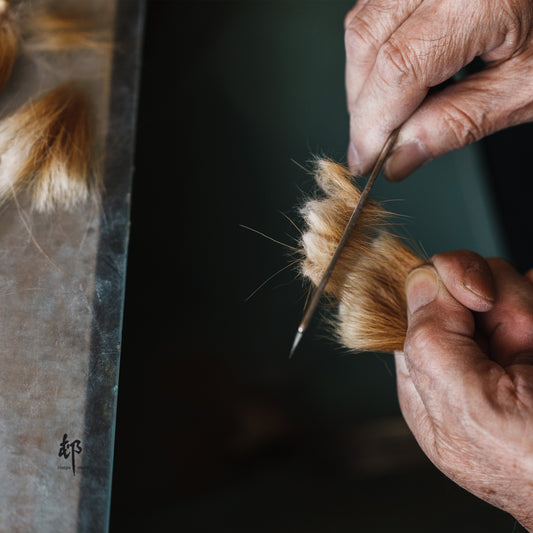Tips on selecting tools for Suibokuga beginners
For those new to Suibokuga or Sumi-e painting, the key points in selecting tools are "well-made tools" and "ease of control." The allure of Suibokuga or Sumi-e, such as the gradation of sumi ink and brush strokes, is much deeper than one might expect. Therefore, it's important not to feel overwhelmed and discouraged 😞 by its complexity right from the start, but rather to prioritize "enjoyment."
Hence, it's crucial to have good quality brushes. Well-made brushes will provide the joy and excitement of painting, even amidst the struggles such as "Oh, it's completely black 😅, I can't achieve the gradation," "Oh, there's too much water 💦," or "Huh, now the sumi ink won't hold and has dried up 💦."
Since there are many tools that need to be prepared initially, you may want to start by getting a good brush first and upgrade other tools once you become accustomed.

FUDE
Suibokuga brushes, known as "GAHITSU (画筆)," are distinct from calligraphy brushes. In calligraphy, brushes are held upright, while in suibokuga painting, brushes are often slightly laid down, known as "sokuhitsu" or "side brushes," which affects their construction. While the difference may not be apparent visually, when you start painting, you'll likely find that painting brushes are more conducive to expressing Suibokuga painting techniques.
Types: Starting with a brush approximately 1-1.5 centimeters thick, such as a "Tatetsuke Fude" or a type called "Chouryu," can be convenient. As you become more experienced, you may find yourself wanting brushes of different sizes, shapes, and types for drawing various lines. A larger-sized Tatetsuke Fude works well.
One of the reasons that makes brush selection difficult is the lack of industry standards. For example, not all brushes with functions similar to "Tatetsuke Fude" are labeled as such, nor are they all named "Chouryu." Even the brushes offered at rimpamura, such as "Kashin" and "Kasui," are referred to by their individual names, not labeled as "Choryu," and they actually differ slightly from Choryu with additional functionality.
Selection Points: For those new to suibokuga painting, we recommend brushes with stiff bristles that feel firm in center when pressed against paper. Among those recommended, the "SUMIE FUDE (large)" from Hankaido, established 400 years ago, is meticulously crafted and very gentle for beginners. It's a very kind brush that will support beginners nicely. 😊

Sumi Ink
In terms of time efficiency, using liquid ink is an option, but we also recommend solid sumi ink to cultivate the ability to discern the rich differences in Sumi ink black tones, which is the essence of suibokuga painting.
Types: There are various types of solid sumi ink available, but for beginners, we recommend "oil soot sumi ink," which is relatively easy to control. (The ease of control depends on the combination of sumi ink and washi paper, and there are also various types of oil soot sumi ink, so the expression "easy to control" may not be entirely accurate. However, to keep it concise, we'll omit further explanation here.)
If choosing from those available on rimpamura, we recommend "KOKI" from KINKOEN, boasting a 150-year history. It's a well-balanced oil soot ink with excellent characteristics such as diffusion, tonal variation, and baseline rendering. Adorned with a lavish design featuring chrysanthemum motifs and gold leaf, its splendid design is unique to Nara sumi ink.

Inkstone
Most people are drawn to the enchanting world of Suibokuga painting, which is predominantly expressed through the subtle tones of sumi ink. The richness of these expressions heavily relies on the suzuri (ink tones), and the suzuri plays a significant role in producing such rich tones.
While many may get tempted to use the time spent grinding sumi ink as time taken away from actual painting, we urge you to try grinding solid sumi ink. You may find that grinding sumi ink and aligning your thoughts can actually be a shortcut to achieving better expressions. Some may have experienced frustration from the time-consuming process of grinding sumi ink, but a good suzuri should allow the ink to flow smoothly without any hindrance.
At rimpamura, we introduce the Akama suzuri from Hieda Gyokuhodo, featuring a gentle and warm reddish tone of the Akama stone, complemented by a modern and beautiful form suitable for contemporary lifestyles. Besides its meticulous stone quality, it contains ample quartz and iron elements necessary for grinding sumi ink, making it ideal for delicate calligraphy and Suibokuga painting. Its compact size, approximately 9cm in diameter, also makes it convenient for transport

Paper Weight, Suiteki, Shitajiki and other tools
Bunchin (Paperweight): Beautiful stationery enhances the experience of enjoying suibokuga painting but anything that can serve as a weight can be used as a substitute.
Suiteki (Water Dropper): Used to pour water for grinding sumi ink on an inkstone and adjusting the density of the sumi ink. There are many ceramic small water droppers available that produce a clear sound when pouring water. Small soy sauce dispensers or pipettes can also be used as substitutes.
Shitajiki (Desk Pad): When painting ink wash, please prepare a white desk pad that makes it easy to see the ink color. There are various thicknesses available, but a slightly thicker one feels easier to paint on.
Brush Cloth: One of the most challenging aspects when starting suibokuga painting is controlling the water content in the brush. Poor ink retention leads to ink running out too quickly, while excessive water causes excessive bleeding. It's a struggle. Experience plays a significant role, so simply continuing to paint is essential. However, you can improve control by quickly wiping off excess water from the brush tip. Regular towels can leave fibers stuck to the brush, which is why I recommend using 100% cotton cloth used as a baby diaper. It has excellent absorbency and the fibers of the cloth are less likely to stick to the brush, making it very useful.
Brush Washer: There are dedicated ceramic and plastic brush washers available, but plastic cups are also very useful.
White Dishes: When painting Suibokuga, it's always beneficial to have different shades of ink, such as dark, medium, and light, prepared in advance. Therefore, it's good to have about three flat dishes with a diameter of around 10 cm each. White dishes are preferred to better distinguish the ink colors.

contact us anytime!
Currently, rimpamura does not carry washi paper, gassen paper, or other related products. However, we can arrange according to your preferences. If you have any questions, please feel free to contact us at shop@rimpamura.com.
what's new
View all-

Maki Fude (cored brushes) vs Suihitsu (non-core...
A Makifude has Japanese paper wrapped around its core; therefore, only about one-third of the bristles on a Makifude brush are exposed for use, while the bristles of a Suihitsu...
Maki Fude (cored brushes) vs Suihitsu (non-core...
A Makifude has Japanese paper wrapped around its core; therefore, only about one-third of the bristles on a Makifude brush are exposed for use, while the bristles of a Suihitsu...
-

Two different ways of making brushes
Fude making has been practiced throughout Japan for centuries, and while the manufacturing methods can vary somewhat depending on the region and shokunin, they can be broadly categorized into two...
Two different ways of making brushes
Fude making has been practiced throughout Japan for centuries, and while the manufacturing methods can vary somewhat depending on the region and shokunin, they can be broadly categorized into two...
-

Season of Sumi making is over this year. Sumi i...
The production of sumi ink takes place during winter. This is because one of the raw materials for sumi, Nikawa glue, may not solidify or may even rot when it...
Season of Sumi making is over this year. Sumi i...
The production of sumi ink takes place during winter. This is because one of the raw materials for sumi, Nikawa glue, may not solidify or may even rot when it...
-

Yoichi Hieda awarded at the 47th Yamaguchi Trad...
It is our great pleasure to announce that Yoichi Hieda is awarded the "Japan Crafts Association Yamaguchi Branch Director's Award", the equivalent of the first prize, at the 47th Yamaguchi...
Yoichi Hieda awarded at the 47th Yamaguchi Trad...
It is our great pleasure to announce that Yoichi Hieda is awarded the "Japan Crafts Association Yamaguchi Branch Director's Award", the equivalent of the first prize, at the 47th Yamaguchi...




